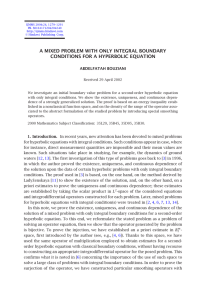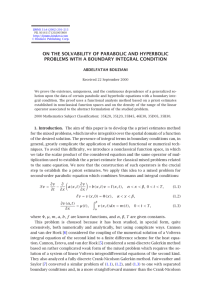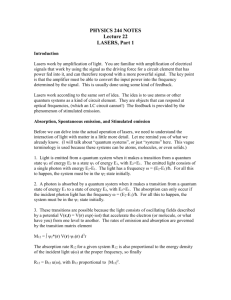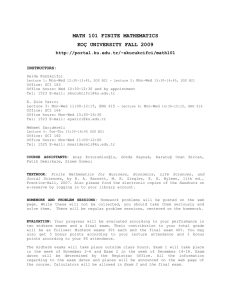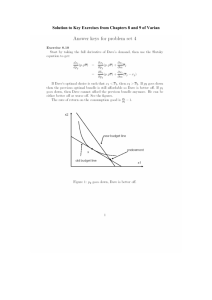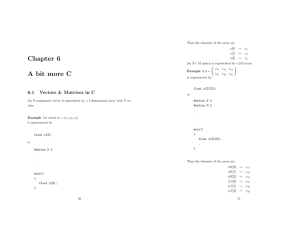ROTHE TIME-DISCRETIZATION METHOD FOR THE SEMILINEAR HEAT EQUATION SUBJECT TO
advertisement
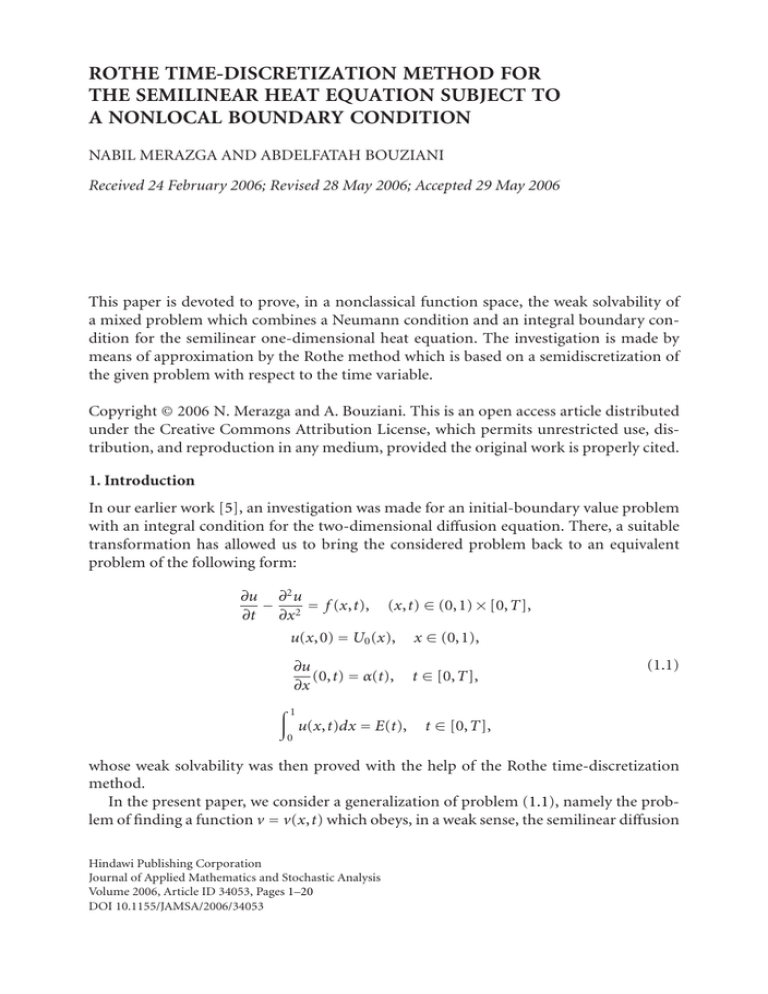
ROTHE TIME-DISCRETIZATION METHOD FOR
THE SEMILINEAR HEAT EQUATION SUBJECT TO
A NONLOCAL BOUNDARY CONDITION
NABIL MERAZGA AND ABDELFATAH BOUZIANI
Received 24 February 2006; Revised 28 May 2006; Accepted 29 May 2006
This paper is devoted to prove, in a nonclassical function space, the weak solvability of
a mixed problem which combines a Neumann condition and an integral boundary condition for the semilinear one-dimensional heat equation. The investigation is made by
means of approximation by the Rothe method which is based on a semidiscretization of
the given problem with respect to the time variable.
Copyright © 2006 N. Merazga and A. Bouziani. This is an open access article distributed
under the Creative Commons Attribution License, which permits unrestricted use, distribution, and reproduction in any medium, provided the original work is properly cited.
1. Introduction
In our earlier work [5], an investigation was made for an initial-boundary value problem
with an integral condition for the two-dimensional diffusion equation. There, a suitable
transformation has allowed us to bring the considered problem back to an equivalent
problem of the following form:
∂u ∂2 u
−
= f (x,t),
∂t ∂x2
(x,t) ∈ (0,1) × [0,T],
u(x,0) = U0 (x),
x ∈ (0,1),
∂u
(0,t) = α(t),
∂x
t ∈ [0,T],
1
0
u(x,t)dx = E(t),
(1.1)
t ∈ [0,T],
whose weak solvability was then proved with the help of the Rothe time-discretization
method.
In the present paper, we consider a generalization of problem (1.1), namely the problem of finding a function v = v(x,t) which obeys, in a weak sense, the semilinear diffusion
Hindawi Publishing Corporation
Journal of Applied Mathematics and Stochastic Analysis
Volume 2006, Article ID 34053, Pages 1–20
DOI 10.1155/JAMSA/2006/34053
2
A semilinear heat equation with a nonlocal condition
equation
∂v ∂2 v
−
= f(x,t,v),
∂t ∂x2
(x,t) ∈ (0,1) × [0,T],
(1.2)
subject to the initial condition
v(x,0) = V0 (x),
x ∈ [0,1],
(1.3)
∂v
(0,t) = g(t),
∂x
t ∈ [0,T],
(1.4)
the Neumann condition
and the integral boundary condition
1
0
v(x,t)dx = E(t),
t ∈ [0,T],
(1.5)
where f, V0 , g, and E are given functions, and T is a positive constant.
The method used here to investigate problem (1.2)–(1.5) is the same as in [5], the socalled “Rothe method.” However, the presence of the semilinearity in (1.2) complicates
the process of derivating the necessary a priori estimates and proving the convergence of
the method. Moreover, we follow in Section 5 a slightly different way which is simpler
and shorter than the one in [5].
It is interesting to note that problem (1.2)–(1.5) has, like (1.1), many practical interpretations in the context of chemical engineering, thermoelasticity, heat conduction
theory, population dynamics, and so forth (see the references in [5]).
Introducing a new unknown function u by setting
u(x,t) = v(x,t) − r(x,t),
(1.6)
where
r(x,t) = g(t) x −
1
+ E(t),
2
(1.7)
it clearly follows that u satisfies the following problem:
∂u ∂2 u
−
= f (x,t,u), (x,t) ∈ (0,1) × I,
∂t ∂x2
u(x,0) = U0 (x), x ∈ [0,1],
∂u
(0,t) = 0,
∂x
1
0
u(x,t)dx = 0,
t ∈ I,
t ∈ I,
(1.8)
(1.9)
(1.10)
(1.11)
N. Merazga and A. Bouziani 3
where I stands for the time interval [0,T] and
∂r(x,t)
,
∂t
U0 (x) := V0 (x) − r(x,0).
f (x,t,u) := f(x,t,u + r) −
(1.12)
Hence, instead of studying directly the problem (1.2)–(1.5), we concentrate our attention on problem (1.8)–(1.11). Once u is known, the function v is immediately obtained
through the relation v = u + r.
The plan of the paper is as follows. In Section 2, notations, assumptions on data, and
some useful results are given before stating the precise sense of the required solution as
well as the main result of the paper. In Section 3, a semidiscretization in time of problem
(1.8)–(1.11) is performed to construct approximate solutions, the so-called “Rothe approximations.” Some necessary a priori estimates for these approximations are derived in
Section 4, and then used, in Section 5, to establish a convergence and existence result for
the problem under study.
2. Preliminaries
In the course of the paper, (·, ·) denotes the usual scalar product in L2 (0,1) and · the
corresponding norm, while H 2 (0,1) denotes the usual (real) second-order Sobolev space
on (0,1) with norm · H 2 (0,1) . Let V be the set which we define as follows:
V := φ ∈ L2 (0,1);
1
0
φ(x)dx = 0 .
(2.1)
Clearly, V is a Hilbert space for (·, ·).
In addition to the standard functional spaces of the types C(I,X), C 0,1 (I,X), L2 (I,X),
and L∞ (I,X) of continuous, Lipschitz-continuous, L2 -Bochner integrable, and essentially
bounded functions from I into a Banach space X, respectively (see, e.g., [4]), our analysis
requires also the use of the nonclassical function space B21 (0,1) introduced by the second author (see, e.g., [1, 2]) as the completion of the space C0 (0,1) of real continuous
functions with compact support in (0,1) with respect to the inner product
(u,v) =
1
B21
where x v =
norm, that is,
x
0
0
x u · x v dx,
(2.2)
v(ξ)dξ for every fixed x ∈ (0,1). If · B21 denotes the corresponding
v B21 = (v,v)B21 ,
(2.3)
then, the inequality
v 2B1 2
1
v 2
2
(2.4)
holds for every v ∈ L2 (0,1), and hence the embedding L2 (0,1) → B21 (0,1) is continuous.
4
A semilinear heat equation with a nonlocal condition
We should note that any given real function θ(x,t) on (0,1) × I is automatically identified with the corresponding abstract function t → θ(t) = θ(·,t) defined from I into some
functional space on (0,1) by setting (θ(t))(x) = θ(x,t) for x ∈ (0,1).
Strong and weak convergence are denoted by → or , respectively, and the symbol c
will stand for generic positive constants which may be different in the same discussion.
At several places, we will use the following continuous and discrete forms of Gronwall
lemma.
Lemma 2.1. (i) Let x(t) 0, h(t), y(t) be real integrable functions on the interval [a,b]. If
y(t) h(t) +
t
a
x(τ)y(τ)dτ,
∀t ∈ [a,b],
(2.5)
then
y(t) h(t) +
t
t
a
h(τ)x(τ)exp
τ
∀t ∈ [a,b].
x(s)ds dτ,
(2.6)
In particular, if x(τ) ≡ C is a constant and h(τ) is nondecreasing, then
y(t) h(t)eC(t−a) ,
∀t ∈ [a,b].
(2.7)
(ii) Let {ai } be a sequence of real nonnegative numbers satisfying
a1 A,
ai A + Bh
i −1
ak ,
(2.8)
∀i = 2,...,
k =1
where A, B, and h are positives constants. Then
ai AeB(i−1)h ,
∀i = 1,2,....
(2.9)
Proof. The proof of assertion (i) is the same as in [3, Lemma 1.3.19]. As for assertion (ii),
it suffices to see that from our hypothesis, the following estimate follows:
ai A(1 + Bh)i−1 ,
∀i = 1,2,....
(2.10)
Indeed, we have first a1 A and a2 A + a1 Bh A(1 + Bh). Next, let us suppose that
ak A(1 + Bh)k−1 holds for all k = 1,...,i − 1, then
ai A + Bh
i −1
A(1 + Bh)k−1 = A 1 + Bh
k =1
= A 1 + Bh
1 − (1 + Bh)i−1
1 − (1 + Bh)
i −1
(1 + Bh)k−1
k =1
(2.11)
= A(1 + Bh)i−1 .
Hence, using the elementary inequality 1 + t et , for all t ∈ R+ , we have ai AeB(i−1)h ,
which was to be proved.
N. Merazga and A. Bouziani 5
Also, the elementary Cauchy inequality
1
ε
αβ α2 + β2 ,
2
2ε
∀α,β ∈ R, ∀ε ∈ R∗
+,
(2.12)
will be useful to us thereafter.
Throughout the paper, we assume that
(H1) f (t,w) ∈ L2 (0,1) for each pair (t,w) ∈ I × L2 (0,1) and the Lipschitz condition
f (t,w) − f (t ,w ) 1 l |t − t | 1 + w 1 + w 1 + w − w 1 ,
B2
B2
B2
B2
(2.13)
for all t,t ∈ I, for all w,w
∈ V , holds for some positive constant l;
(H2) U0 ∈ H 2 (0,1);
1
(H3) (dU0 /dx)(0) = 0 and 0 U0 (x)dx = 0, for consistency.
We will be concerned with a weak solution in the following sense.
Definition 2.2. Under a weak solution of problem (1.8)–(1.11), a function u : I → L2 (0,1)
is understood such that
(i) u ∈ L∞ (I,V ) ∩ C 0,1 (I,B21 (0,1));
(ii) u has (a.e. in I) a strong derivative du/dt ∈ L∞ (I,B21 (0,1));
(iii) u(0) = U0 in B21 (0,1);
(iv) the identity
du
(t),φ
dt
B21
+ u(t),φ = f t,u(t) ,φ
B21
(2.14)
takes place for all φ ∈ V and a.e. t ∈ I.
We remark that the fulfillment of the integral condition (1.11) is included in the fact
that u(t) ∈ V for a.e. t ∈ I.
To close this section, we announce the main result of the paper.
Theorem 2.3. Under assumptions (H1)–(H3), problem (1.8)–(1.11) admits a unique
weak solution u in the sense of Definition 2.2 that depends continuously on the right-hand
side f and the initial function U0 . Moreover, the following convergence properties hold:
u(n) −→ u
u(n) (t)
du(n)
dt
in C I,B21 (0,1) ,
u(t)
du
dt
in V , ∀t ∈ I,
(2.15)
in L2 I,B21 (0,1) ,
as n tends to infinity, where {u(n) }n is the sequence of Rothe approximations defined in (3.7).
The proof of this result will be carried out along the following sections.
6
A semilinear heat equation with a nonlocal condition
3. Rothe approximations
Let n be a positive integer. Following the idea of Rothe, we solve the recurrent system of
time-discretized problems:
δu j −
d2 u j
= f j , x ∈ (0,1),
dx2
du j
(0) = 0,
dx
1
0
(3.1) j
(3.2) j
u j (x)dx = 0,
(3.3) j
successively for j = 1,...,n, commencing with the initial value u0 = U0 , where t j = jh,
h = T/n, and
u j − u j −1
,
h
f j (x) := f x,t j ,u j −1 .
δu j :=
(3.1)
For the functions u j which can be viewed as backward finite difference approximations
of u(t j , ·), we have the following result.
Theorem 3.1. For all n 1 and for all j = 1,...,n, problem (3.1)j –(3.3)j possesses a unique
solution u j in H 2 (0,1).
Proof. Similarly as in [5], the proof consists of the following two steps.
Step 1. We first look for the functions w j (x) = w j (x;λ) which solve the associated classical
Neumann boundary value problems
−
d2 w j 1
+ wj = Fj,
dx2 h
dw j
(0) = 0,
dx
x ∈ (0,1),
dw j
(1) = λ,
dx
(3.4) j
successively for j = 1,...,n, where F j (x) := f (x,t j ,w j −1 ) + (1/h)w j −1 (x), w0 = U0 and λ is
a real parameter.
Since, according to assumptions (H1) and (H2), F1 := f (t1 ,U0 ) + (1/h)U0 ∈ L2 (0,1),
the Lax-Milgram lemma guarantees the existence and uniqueness of a strong solution
w1 = w1 (·;λ) ∈ H 2 (0,1) to the elliptic problem (3.4)1 . Then F2 := f (t2 ,w1 ) + (1/h)w1 ∈
L2 (0,1), so that problem (3.4)2 admits a unique strong solution w2 = w2 (·;λ) ∈ H 2 (0,1)
thanks to Lax-Milgram lemma. Step by step, each w j is then uniquely determined in
terms of U0 , w1 ,...,w j −1 . Thus, for all n 1 and all λ ∈ R, the auxiliary problems (3.4)j ,
j = 1,...,n, have unique solutions w j ∈ H 2 (0,1).
Step 2. Now, let us show that for all j = 1,...,n, the parameter λ can be selected in a
suitable way such that the corresponding function w j (·;λ) is exactly a solution of problem
(3.1)j –(3.3)j . Obviously, this happens if and only if λ is a root of the real function Φ j (λ)
defined by
Φ j (λ) :=
1
0
w j (x;λ)dx,
(3.5) j
N. Merazga and A. Bouziani 7
so that solving the equation Φ j (λ) = 0 will provide all the solutions to problem (3.1)j –
(3.3)j . If, in particular, this equation admits a unique solution, so is problem (3.1)j –(3.3)j .
From the superposition principle, we have that
w j (·;λ) = w j (·;0) + χ(·;λ),
(3.2)
where w j (·;0) is the solution (uniquely determined) to problem (3.4)j for λ = 0 and χ is
the (unique) solution to the following problem:
−
d2 χ 1
+ χ = 0,
dx2 h
x ∈ (0,1),
dχ
(0) = 0,
dx
(3.3)
dχ
(1) = λ.
dx
One can readily find that χ is given by
√
cosh(x/ h)
√
,
χ(x;λ) = λ h
(3.4)
sinh(1/ h)
so that, replacing into (3.5)j , this yields
√
λ h
√
Φ j (λ) =
sinh(1/ h)
1
0
x
dx +
h
cosh √
1
0
w j (x;0)dx,
(3.5)
that is,
Φ j (λ) = hλ +
1
0
w j (x;0)dx,
(3.6)
which shows that for all h > 0, Φ j admits a unique root λ = λ j ∈ R, namely λ j =
1
−(1/h) 0 w j (x;0)dx. Hence, problem (3.1)j –(3.3)j is uniquely solvable for all n 1 and
all j = 1,...,n. Therefore, Theorem 3.1 has been proved.
Now, for all n 1, we introduce the Rothe approximation u(n) : I → H 2 (0,1) ∩ V is
defined by
u(n) (t) = u j −1 + δu j t − t j −1 ,
t ∈ t j −1 ,t j , j = 1,...,n,
(3.7)
and the corresponding step function u(n) : I → H 2 (0,1) ∩ V is defined as follows:
(n)
⎧
⎨u j
u (t) = ⎩
U0
for t ∈ t j −1 ,t j , j = 1,...,n,
for t = 0.
(3.8)
We expect that the limit limn→∞ u(n) = u exists in a suitable sense, and that is precisely
the desired weak solution to our problem (1.8)–(1.11). The establishment of this fact
requires some a priori estimates whose derivation is the subject of the following section.
8
A semilinear heat equation with a nonlocal condition
4. A priori estimates for the approximations
Lemma 4.1. There exist c > 0 such that for all n 1, the solutions u j of the time-discretized
problems (3.1)j –(3.3)j , j = 1,...,n, obey the estimates
u j c,
δu j 1 c.
(4.1)
(4.2)
B2
Proof. The key point to establish these estimates is the derivation of a nonstandard variational formulation of problems (3.1)j –(3.3)j . To this aim, we take, for all j = 1,...,n, the
inner product in B21 (0,1) of (3.1)j with any function φ from the space V defined in (2.1)
to get
δu j ,φ
B21 (0,1)
−
d2 u j
,φ
dx2
B21 (0,1)
= ( f j ,φ)B21 (0,1) .
(4.3)
But from (3.2)j we have
d2 u j
,φ
dx2
B21 (0,1)
=
1
du j
(x)x φ dx
dx
0
x =1 1
= u j (x)x φ
− u j φ dx,
x =0
(4.4)
0
then
d2 u j
,φ
dx2
B21 (0,1)
= − u j ,φ ,
(4.5)
since φ ∈ V . Substituting in (4.3), this yields the required variational form:
δu j ,φ
B21 (0,1) +
u j ,φ = f j ,φ
B21 (0,1) ,
(4.4) j
which gives for j = 1 that
δu1 ,φ
B21 (0,1) + h
δu1 ,φ = f1 ,φ
B21 (0,1) −
U0 ,φ ,
∀φ ∈ V.
(4.6)
Integrating by parts the second term in the right-hand side of (4.6), we have
U0 ,φ =
1
0
U0 (x)
d
x φ dx
dx
x=1 1 dU
0
= U0 (x)x φ
−
(x)x φ dx
=−
1
0
x =0
0
dx
(4.7)
dU0
(x)x φdx,
dx
but, due to assumption (H3)1 , we note that
x
d2 U0
dU0
(x) =
(x) ∀x ∈ (0,1),
dx2
dx
(4.8)
N. Merazga and A. Bouziani 9
whence
U0 ,φ = −
1
0
x
d2 U0
(x) x φ dx,
dx2
(4.9)
so that (4.6) becomes
δu1 ,φ
B21 (0,1)
+ h δu1 ,φ = f1 +
d2 U0
,φ
dx2
B21 (0,1)
,
∀φ ∈ V.
(4.10)
Testing this last equality with φ = δu1 = (u1 − U0 )/h which is clearly an element of V
because of (3.3)1 and assumption (H3)2 , we derive with the help of Cauchy-Schwarz inequality
δu1 2 1 + hδu1 2 f1 B2
2 d U0 δu1 1 ,
B21 + B2
2
1
dx
(4.11)
B2
consequently
δu1 B21
d 2 U0 f t1 ,U0 B21 + dx2 1 ,
B2
(4.12)
and then
δu1 B21
max f t,U0 t ∈I
2 d U0 B21 + dx2 B21
:= c1 .
(4.13)
Next, subtracting (4.4)j −1 from (4.4)j ( j = 2,...,n) and putting φ = δu j which belongs to
V in view of (3.3)j −1 and (3.3)j , we estimate
δu j 2 1 + 1 u j − u j −1 2 f j − f j −1 1 + δu j −1 1 δu j 1 ,
B2
B2
B2
B2
h
(4.14)
which implies that
δu j B21
f j − f j −1 B21 + δu j −1 B21 ,
(4.15)
B21
j
fi − fi−1 1 + δu1 1 .
B2
B2
(4.16)
then, iterating we may arrive at
δu j i =2
But owing to assumption (H1), we have for all i 2 that
fi − fi−1 1 = f ti ,ui−1 − f ti−1 ,ui−2 1
B2
B2
l h 1 + ui−1 1 + ui−2 1 + ui−1 − ui−2 1
B2
B2
= lh 1 + ui−1 B21 + ui−2 B21 + δui−1 B21 ,
B2
(4.17)
10
A semilinear heat equation with a nonlocal condition
so that
j
j −1
j −2
j −1
fi − fi−1 1 lh ( j − 1) +
u i 1 +
u i 1 +
δui 1
B2
B2
B2
B2
i=2
i =1
i=0
j −1
l( j − 1)h + 2lh ui i =1
1 + lh U0
B2
i =1
j −1
δui 1 .
1 + lh
B2
B2
(4.18)
i =1
To dominate the right-hand side in (4.18), we need to estimate the term ui B21 . For this,
we take φ = ui in (4.4)i , i = 1,...,n, and get
1
ui 2 1 + ui 2 fi 1 + 1 ui−1 1 ui 1 ,
B2
B2
B2
B2
h
h
from where we derive
u i h fi B21 + ui−1 B21
B21
(4.19)
h fi B21 + fi−1 B21 + ui−2 B21 ,
(4.20)
and from this recurrent inequality, we successively estimate
u i B21
h
i
fk k =1
B21
+ U0 B21 .
(4.21)
Invoking assumption (H1), we have for all k 1 that
fk B21
f tk ,uk−1 − f tk ,0 B21 + f tk ,0 B21
luk−1 B21 + M,
(4.22)
where M := maxt∈I f (t,0)B21 < +∞. Substituting (4.22) in the previous inequality, we
get
u i B21
h
i l u k −1 k =1
B21
+ M + U0 B21
i
u k −1 1
= ihM + (1 + lh)U0 B21 + lh
B2
(4.23)
k =2
TM + (1 + lh)U0 B21 + lh
i −1
u k 1 ,
B2
k =1
from where it comes due to the discrete Gronwall’s lemma that
u i B21
TM + (1 + lh)U0 B21 el(i−1)h ,
(4.24)
hence
u i B21
TM + (1 + lT)U0 B21 elT := c2 .
(4.25)
N. Merazga and A. Bouziani 11
Now, returning to (4.18), we can write thanks to (4.25) that
j
j −1
fi − fi−1 1 l( j − 1)h + lh 2( j − 1)c2 + U0 1 + lh
δui 1
B2
B2
B2
i=2
i=1
j −1
lT 1 + 2c2 + U0 B21 + lh δui B21 .
(4.26)
i =1
Combining (4.13), (4.16), and the last inequality, we have
δu j B21
c1 + lT 1 + 2c2 + U0 B21 + lh
j −1
δui 1 ,
B2
(4.27)
i =1
hence, applying Gronwall’s lemma in discrete form again, we get
δu j B21
c1 + lT 1 + 2c2 + U0 B21
el( j −1)h .
(4.28)
Thus, estimate (4.2) is proved for c = c3 with
c3 := c1 + lT 1 + 2c2 + U0 B21
elT .
(4.29)
Next, to derive estimate (4.1), we insert φ = u j − u j −1 in (4.4)j and apply the identity
u j ,u j − u j −1 =
1 u j − u j −1 2 + u j 2 − u j −1 2 ,
2
(4.30)
to get
2
2 1 2 2
1
1
hδu j B21 + u j − u j −1 + u j = f j ,u j − u j −1 B21 + u j −1 .
2
2
2
(4.31)
Ignoring the first two terms in the left-hand side, we obtain
2
u j 2 f j 1 u j − u j −1 1 + u j −1 2 ,
B2
B2
(4.32)
whence, using (4.22), (4.25), and (4.2),
2
u j 2h lc2 + M c3 + u j −1 2 .
(4.33)
So, by an iterative procedure, we get
2
u j 2 jh lc2 + M c3 + U0 2 ,
(4.34)
from where estimate (4.1) follows with c = c4 , where
2 1/2
c4 := 2T lc2 + M c3 + U0 and so the proof is complete.
,
(4.35)
12
A semilinear heat equation with a nonlocal condition
If we extend, for all n 1, the function u(n) defined on I to the interval [−T/n,0) by
setting
u(n) (t) = U0 ,
T
∀t ∈ − ,0 ,
(4.36)
n
we can state the following corollary.
Corollary 4.2. For all n 1, the functions u(n) and u(n) satisfy the estimates
(n) u (t) c,
(n) u (t) c,
(n) du
dt (t)
B21
c,
(n)
u (t) − u(n) (t)
B21
(4.37)
a.e. in I,
c
,
n
(n)
u (t) − u(n) t − T n ∀t ∈ I,
B21
(4.38)
∀t ∈ I,
c
,
n
(4.39)
∀t ∈ I.
(4.40)
Proof. Both estimates (4.37) follow immediately from (4.1) with the same constant c = c4 .
On the other hand, invoking the identity
∀t ∈ t j −1 ,t j , 1 j n,
du(n)
(t) = δu j ,
dt
(4.41)
estimate (4.38) is seen to be an easy consequence of estimate (4.2) with c = c3 . Next,
observing that we have
(n)
(n)
⎧
⎨ t j − t δu j ,
u (t) − u (t) = ⎩
0,
(n)
(n)
u (t) − u
∀t ∈ t j −1 ,t j , 1 j n,
⎧
⎨u j − u j −1 ,
t = 0,
∀t ∈ t j −1 ,t j , 1 j n,
T
t−
=
⎩0,
n
(4.42)
t = 0,
we can write
(n)
u (t) − u(n) (t)
B21
h max δu j B21
(n)
u (t) − u(n) t − T n ∀t ∈ I,
1 j n
B21
h max δu j B21 ,
1 j n
(4.43)
∀t ∈ I,
hence, in view of (4.2), we get the required estimates (4.39) and (4.40) with c = c3 T.
5. Existence, uniqueness, and convergence of the method
Let us define, for all n 1, the abstract step function f
f
(n)
(t,v) = f t j ,v ,
(n)
∀t ∈ t j −1 ,t j ,
: I × V → L2 (0,1) by
j = 1,...,n.
(5.1)
N. Merazga and A. Bouziani 13
Then, the variational equations (4.4)j may be rewritten in the form
du(n)
(t),φ
dt
B21
(n)
+ u(n) (t),φ = f
t,u(n) t −
T
n
,φ
B21
(5.1)n
,
for all φ ∈ V and t ∈ (0,T].
It is convenient to present now a basic convergence statement.
Theorem 5.1. The sequence {u(n) }n converges in the norm of the space C(I,B21 (0,1)) to
some function u ∈ C(I,B21 (0,1)) and the error estimate
(n)
u − u C(I,B21 (0,1))
c
(5.2)
n1/2
holds for all n 1.
Proof. The idea of the proof consists in showing that {u(n) }n is a Cauchy sequence in the
Banach space C(I,B21 (0,1)).
Let u(n) and u(m) be the Rothe approximations corresponding to the step lengths hn =
T/n and hm = T/m, respectively, with m > n 1. Take the difference (5.1)n –(5.1)m tested
with φ = u(n) (t) − u(m) (t)(∈ V ), this yields for all t ∈ (0,T] that
d (n)
u (t) − u(m) (t) ,u(n) (t) − u(m) (t)
dt
=
f
(n)
t,u(n) t −
T
n
−f
(m)
B21
+ u(n) (t) − u(m) (t),u(n) (t) − u(m) (t)
t,u(m) t −
T
m
,u(n) (t) − u(m) (t)
B21
,
(5.3)
or after some rearrangement,
1 d
u(n) (t) − u(m) (t)2 1 + u(n) (t) − u(m) (t)2
B2
2 dt
= u(n) (t) − u(m) (t),u(n) (t) − u(m) (t) − u(n) (t) + u(m) (t)
+ f
(n)
t,u(n) t −
T
n
−f
(m)
t,u(m) t −
T
m
(5.4)
,u(n) (t) − u(m) (t)
B21
.
But since we have
f
(n)
t,u(n) t −
T
n
∀t ∈ t j −1 ,t j , j = 1,...,n,
= f t j ,u j −1 := f j ,
(5.5)
it follows in view of (4.22) that
(n)
T (n)
f
t,u
t
−
n B21
max f j B21
1 j n
l max u j −1 B21 + M,
1 j n
(5.6)
∀t ∈ (0,T],
14
A semilinear heat equation with a nonlocal condition
hence due to (4.25),
(n)
T (n)
f
t,u
t
−
n B21
lc2 + M,
∀t ∈ (0,T].
(5.7)
∀t ∈ (0,T], ∀φ ∈ V ,
(5.8)
Thus, estimating the identity
u(n) (t),φ = f
(n)
t,u(n) t −
T
n
−
du(n)
(t),φ
dt
B21
,
which follows from (5.1)n , we obtain owing to (4.38) that
(n)
u (t),φ f (n) t,u(n) t − T
n c5 φB21 ,
(n) du
+
dt (t) 1 φ B21
1
B2
B2
(5.9)
∀t ∈ (0,T],
with c5 := lc2 + M + c3 . This, together with (4.39), allows us to majorize the first term in
the right-hand side of (5.4) as follows:
u(n) (t) − u(m) (t),u(n) (t) − u(m) (t) − u(n) (t) + u(m) (t)
2c5 u(n) (t) − u(n) (t)B21 + u(m) (t) − u(m) (t)B21
c6
1 1
,
+
n m
(5.10)
∀t ∈ (0,T],
with c6 := 2c5 c3 T.
On the other hand, thanks to the Cauchy inequality (2.12), we can write for every ε > 0
that
f
(n)
t,u(n) t −
T
n
−f
(m)
t,u(m) t −
T
m
,u(n) (t) − u(m) (t)
B21
(n)
(m)
T
T (n)
(m)
u(n) (t) − u(m) (t) 1
f
t,u
t
−
f
t,u
t
−
−
B2
1
n
m
B2
2
(m)
ε (n)
T
T (n)
(m)
f
t,u
t
−
f
t,u
t
−
−
2
n
m 1
B2
2
1
+ u(n) (t) − u(m) (t)B21 ,
2ε
∀t ∈ (0,T].
(5.11)
Now, let t be arbitrary but fixed in (0,T], then there exist two integers k and i corresponding to the subdivision of I into n and m subintervals, respectively, such that
N. Merazga and A. Bouziani 15
t ∈ (tk−1 ,tk ] ∩ (ti−1 ,ti ], hence from assumption (H1), it follows that
2
(n)
(m)
T
T (n)
(m)
f
t,u
t
−
f
t,u
t
−
−
n
m 1
B2
2
T
T (n)
(m)
=
f
t
,u
t
−
f
t
,u
t
−
−
k
i
n
m 1
(n)
T 2 l
tk − ti 1 + u
t
−
n B2
(m)
T
+
u
t−
1
m 1
B2
B2
2
(n)
T
T (m)
+ u
t−
t−
−u
n
m 1
l
(5.12)
B2
2
(n)
T
hn + hm 1 + uk−1 B21 + ui−1 B21 + t−
− u(n) (t)
u
1
n
B2
+ u(n) (t) − u(m) (t)
2
(m)
T (m)
(t) − u
t−
,
B21 + u
m 1
B2
consequently, with consideration to (4.25) and (4.40), we deduce that
2
(n)
(m)
T
T (n)
(m)
f
t,u
t
−
f
t,u
t
−
−
n
m 1
l2 T
=l
2
l
T 1 + 2c2 + c3
2
c72
1 1
+
n m
1
1
+ u(n) (t) − u(m) (t)B21
+
n m
2
+ 2c7
2
2 1
n
+
1
m
2
1 1 u(n) (t) 1 + u(m) (t) 1
+
B2
B2
n m
+ u(n) (t) − u(m) (t)B21
lc7
B2
2
1 1 1 1
1 + 2c2 + c3 T
+ u(n) (t) − u(m) (t)B21
+
+
n m
n m
2
+ 4l2 c7 c2
(5.13)
2
1 1
+ l2 u(n) (t) − u(m) (t)B21
+
n m
for all t ∈ (0,T], with c7 := T(1 + 2c2 + c3 ). Thus, using the notations c8 := (lc7 )2 and
c9 := 4l2 c7 c2 , we write
2
(n)
(m)
T
T f
t,u(n) t −
t,u(m) t −
−f
n
m 1
c8
1 1
+
n m
2
+ c9
1 1
+
n m
B2
2
+ l2 u(n) (t) − u(m) (t) 1 ,
B2
(5.14)
∀t ∈ (0,T],
16
A semilinear heat equation with a nonlocal condition
hence, going back to (5.11), we have
f
(n)
t,u
(n)
T
t−
n
−f
2
(m)
t,u
(m)
T
t−
m
(n)
,u (t) − u
(m)
(t)
B21
2
ε
ε ε
1 1
1 1
c8
+ c9
+ l2 u(n) (t) − u(m) (t)B21
+
+
2
n m
2
n m
2
1
2
+ u(n) (t) − u(m) (t)B21 , ∀t ∈ (0,T].
2ε
(5.15)
Next, combining (5.4), (5.10), and (5.15), we have for all t ∈ (0,T] that
d
u(n) (t) − u(m) (t)2 1 + 2u(n) (t) − u(m) (t)2
B2
dt
εc8
1 1
+
n m
2
+ εc9 + 2c6
1
2
1
+ εl2 u(n) (t) − u(m) (t)B21
+
n m
(5.16)
2
1
+ u(n) (t) − u(m) (t)B21 ,
ε
or
d
u(n) (t) − u(m) (t)2 1 + 2 − εl2 u(n) (t) − u(m) (t)2
B2
dt
εc8
1 1
+
n m
2
+ εc9 + 2c6
1
n
+
2
1
1
+ u(n) (t) − u(m) (t)B21 .
m
ε
(5.17)
Let us choose ε so that 2 − εl2 = 0, that is, ε = 2/l2 and integrate the last inequality over
(0,t). Then, invoking the fact that u(n) (0) = u(m) (0) = U0 , we obtain for all t ∈ I that
(n)
u (t) − u(m) (t)2 1 2c8 T
B2
2
l
l2
+
2
t
0
1 1
+
n m
2
+ 2T
c9
+ c6
l2
1 1
+
n m
(5.18)
(n)
u (τ) − u(m) (τ)2 1 dτ,
B2
giving by Gronwall’s lemma
2
(n)
1 1
2
u (t) − u(m) (t)2 1 c10 1 + 1
+ c11
el t/2
+
B2
n
m
n
∀t ∈ I,
m
(5.19)
with c10 := 2c8 T/l2 and c11 := 2T(c9 /l2 + c6 ). Accordingly,
(n)
u (t) − u(m) (t)
B21
c10
1 1
+
n m
2
+ c11
1 1
+
n m
1/2
el
2 T/4
,
∀t ∈ I,
(5.20)
then, taking the supremum with respect to t in the left-hand side of this inequality, we
have
(n)
u − u(m) C(I,B21 (0,1))
c10
1 1
+
n m
2
+ c11
1 1
+
n m
1/2
el
2 T/4
,
(5.21)
N. Merazga and A. Bouziani 17
which implies the existence of a function u ∈ C(I,B21 (0,1)) such that u(n) → u in this
space. Moreover, passing to the limit m → ∞ in (5.21), we obtain the error estimate (5.2)
√
2
with c = c12 := c10 + c11 el T/4 , which achieves the proof.
Next, some properties of the function u from Theorem 5.1 are listed in the following
theorem.
Theorem 5.2. For the function u from Theorem 5.1, it holds that
(i) u ∈ L∞ (I,V ) ∩ C 0,1 (I,B21 (0,1));
(ii) u is strongly differentiable a.e. in I and du/dt ∈ L∞ (I,B21 (0,1));
(iii) u(n) (t), u(n) (t) u(t) in V for all t ∈ I;
(iv) du(n) /dt du/dt in L2 (I,B21 (0,1)).
Proof. On the basis of estimates (4.37) and (4.38), uniform convergence statement from
Theorem 5.1 and the continuous embedding V B21 (0,1), the assertions of the present
theorem are direct consequences of [3, Lemma 1.3.15].
Gathering all the obtained results, we are in position to state our existence theorem.
Theorem 5.3. There is a unique weak solution to the problem (1.8)–(1.11) in the sense of
Definition 2.2, namely the limit function u from Theorem 5.1.
Proof. In light of what precedes, the properties (i) and (ii) from Definition 2.2 are already fulfilled. Moreover, since u(n) → u in C(I,B21 (0,1)) when n → ∞ and, by definition,
u(n) (0) = U0 , it follows that u(0) = U0 holds in B21 (0,1) so the initial condition (1.9) is
also fulfilled. It remains to show that u satisfies the integral equation (2.14). Integrating
(5.1)n over (0,t) ⊂ I and invoking the fact that u(n) (0) = U0 , we get the approximation
scheme:
u(n) (t) − U0 ,φ
B21
t
+
u(n) (τ),φ dτ =
0
t
0
f
(n)
τ,u(n) τ −
T
n
,φ
B21
dτ.
(5.22)
To investigate the behavior of (5.22) as n → ∞, we need some additional convergence
statements. Since u(n) (t) u(t) in V for all t ∈ I and since for all fixed φ ∈ V , the linear
functional v → (v,φ)B21 is bounded on V , we have
u(n) (t),φ
B21
−→ u(t),φ B21 ,
∀t ∈ I.
(5.23)
On the other hand, in view of the assumed Lipschitz continuity of f , we have
(n)
T
(n)
f
−
τ,u
τ
−
f
τ,u(τ)
n
B21
T
(n)
= f t j ,u
τ−
− f τ,u(τ) n
l t j − τ 1 + u j −1 (5.24)
B21
(n)
T
τ−
,
− u(τ)
B21 + u(τ) B21 + u
n
B21
18
A semilinear heat equation with a nonlocal condition
for all τ ∈ (t j −1 ,t j ], 1 j n, whence
(n)
T
(n)
f
τ,u
τ−
− f τ,u(τ) n
!
c13 T
(n)
l
τ−
+
− u(τ)
u
1 ,
1
n
n
B2
B2
(5.25)
for all τ ∈ (0,T], where c13 := T(1 + c2 + uC(I,B21 (0,1)) ). But owing to the estimates (4.39),
(4.40), and (5.2), we have
(n)
T
u
τ
−
u(τ)
−
n
B21
T
− u(n) (τ)
1
n
B2
(n)
τ−
u
+ u(n) (τ) − u(n) (τ)B21 + u(n) (τ) − u(τ)B21
2c3 T c12
+ 1/2 ,
n
n
∀τ ∈ (0,T],
(5.26)
which in turn implies that
(n)
T
(n)
f
τ,u
τ
−
f
τ,u(τ)
−
n
c13 + 2c3 T + c12 l
,
1
n1/2
B2
∀τ ∈ (0,T],
(5.27)
therefore
f
(n)
T
n
τ,u(n) τ −
−−−→ f τ,u(τ)
in B21 (0,1), ∀τ ∈ (0,T].
n→∞
(5.28)
(n)
Now, due to (5.7) and (5.9), the functions |( f (τ,u(n) (τ − T/n)),φ)B21 | and |(u(n) (τ),φ)|
are uniformly bounded with respect to both τ and n, so the Lebesgue theorem of dominated convergence may be applied to (5.28) as well as to the convergence statement (iii)
from Theorem 5.2 giving
t
0
f
(n)
τ,u(n) τ −
t
0
T
n
,φ
B21
dτ −→
u(n) (τ),φ dτ −→
t
0
t
f τ,u(τ) ,φ
0
u(τ),φ dτ,
∀t ∈ I,
B21 dτ,
∀t ∈ I,
(5.29)
(5.30)
as n → ∞. Then, passing to the limit n → ∞ in (5.22), we obtain by (5.23), (5.29), and
(5.30) that
u(t) − U0 ,φ
B21
t
+
0
u(τ),φ dτ =
t
0
f τ,u(τ) ,φ
B21 dτ,
(5.31)
for all φ ∈ V and t ∈ I. Finally, differentiating this last identity with respect to t recalling
that u : I → B21 (0,1) is strongly differentiable for a.e. t ∈ I, we get the required relation
N. Merazga and A. Bouziani 19
(2.14) thanks to the relation
du
d
u(t),φ B21 =
(t),φ
dt
dt
B21
∀t ∈ I, ∀φ ∈ V.
,
(5.32)
Thus u weakly solves the problem (1.8)–(1.11).
Regarding the uniqueness, let us consider two weak solutions u" and u# of (1.8)–(1.11).
Subtracting the identity (2.14) written for u# from the same identity written for u" and
putting φ = u"(t) − u#(t) in the resulting relation, we get
du
(t),u(t)
dt
B21
2
+ u(t) = f t, u"(t) − f t, u#(t) ,u(t)
∀t ∈ I,
B21 ,
(5.33)
where u := u" − u#. Then, integrating between 0 and t by taking into account that ((du/
dt)(t),u(t))B21 = (1/2)(d/dt)u(t)2B21 and u(0) = 0, we derive
u(t)2 1 + 2
B2
t
0
u(τ)2 dτ = 2
2
t
0
t
2l
0
f τ, u"(τ) − f τ, u#(τ) ,u(τ)
B21 dτ
f τ, u
"(τ) − f τ, u
#(τ) B21 u(τ)B21 dτ
t
u(τ)2 1 dτ,
B2
0
(5.34)
∀t ∈ I,
from where Gronwall’s lemma yields u(t)2B21 = 0, for all t ∈ I, which means that u" =
u#.
To conclude, we give a result of continuous dependence of the solution upon the data.
Theorem 5.4. Let f ∗ : I × L2 (0,1) → L2 (0,1) and U0∗ : [0,1] → R be two given functions
satisfying assumptions (H1)–(H3). If u∗ denotes the weak solution of problem (1.8)–(1.11)
corresponding to the pair ( f ∗ ,U0∗ ) in lieu of ( f ,U0 ), then the inequality
u(t) − u∗ (t)2 1 +
t
B2
0
u(τ) − u∗ (τ)2 dτ
2
U0 − U ∗ 1 +
0
t
B2
0
f τ,u(τ) − f ∗ τ,u∗ (τ) 2 1 dτ
B2
(5.35)
holds for all t ∈ I.
Proof. Subtract identities (2.14) for u and u∗ , put φ = u(t) − u∗ (t), and integrate the
resulting relation over (0,t). we have:
1
u(t) − u∗ (t)2 1 − 1 u(0) − u∗ (0)2 1 +
B2
B2
2
2
=
t
0
f τ,u(τ) − f
∗
t
0
u(t) − u∗ (t)2 dτ
τ,u∗ (τ) ,u(t) − u∗ (t)
B21
(5.36)
dτ,
20
A semilinear heat equation with a nonlocal condition
hence
u(t) − u∗ (t)2 1 + 2
t
B2
0
u(t) − u∗ (t)2 dτ
2
U0 − U ∗ 1 + 2
0
t
B2
0
f τ,u(τ) − f ∗ τ,u∗ (τ) 1 u(t) − u∗ (t) 1 dτ.
B2
B2
(5.37)
The application of (2.12) to the second term in the right-hand side leads to
u(t) − u∗ (t)2 1 +2
t
B2
0
u(t) − u∗ (t)2 dτ
2
U0 − U ∗ 1 +ε
0
B2
t
0
f τ,u(τ) − f ∗ τ,u∗ (τ) 2 1 dτ + 1
B2
ε
t
0
u(t) − u∗ (t)2 1 dτ,
B2
(5.38)
from which inequality (5.35) follows by taking ε = 1. This achieves the proof.
References
[1] A. Bouziani, On the quasi static flexure of a thermoelastic rod, Communications in Applied Analysis 6 (2002), no. 4, 549–568.
, On the solvability of parabolic and hyperbolic problems with a boundary integral condi[2]
tion, International Journal of Mathematics and Mathematical Sciences 31 (2002), no. 4, 201–
213.
[3] J. Kačur, Method of Rothe in Evolution Equations, Teubner-Texte zur Mathematik, vol. 80, BSB B.
G. Teubner Verlagsgesellschaft, Leipzig, 1985.
[4] A. Kufner, O. John, and S. Fučı́k, Function Spaces, Noordhoff International, Leyden, 1977.
[5] N. Merazga and A. Bouziani, Rothe method for a mixed problem with an integral condition for
the two-dimensional diffusion equation, Abstract and Applied Analysis 2003 (2003), no. 16, 899–
922.
Nabil Merazga: Département de Mathématiques, Centre Universitaire Larbi Ben M’hidi,
Oum El Bouagui 04000, Algeria
E-mail address: nabilmerazga@yahoo.fr
Abdelfatah Bouziani: Département de Mathématiques, Centre Universitaire Larbi Ben M’hidi,
Oum El Bouagui 04000, Algeria
E-mail address: af bouziani@hotmail.com



